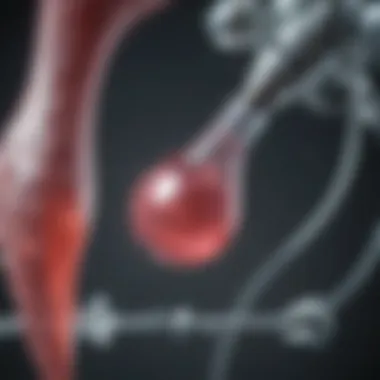Understanding Artificial Insemination Techniques and Ethics


Intro
Artificial insemination represents a significant advancement in reproductive technology, facilitating conception through methods beyond natural intercourse. This technique has gained substantial traction for its effectiveness and ability to address various reproductive challenges. By allowing for controlled breeding and enhancing genetic diversity, artificial insemination serves an essential function in both human and animal reproductive strategies.
Understanding the complexities and developments in this field requires examining its methodologies, applications, and the ethical implications that accompany its use. This article endeavors to unpack these layers, providing a well-rounded perspective on how artificial insemination shapes reproductive health and societal norms.
Key Findings
Major Results
Through a comprehensive analysis, several key findings emerge:
- Effectiveness: Artificial insemination has been demonstrated to significantly increase conception rates in various populations.
- Applications: The technique is not limited to humans, playing a vital role in livestock breeding and conservation efforts.
- Ethical Considerations: Emerging concerns regarding ethical practices arise, particularly concerning consent and genetic manipulation.
- Regulatory Frameworks: There is a range of global regulations that govern artificial insemination practices, impacting access and implementation.
"Artificial insemination has transformed reproductive possibilities, yet it carries both promise and responsibility."
Discussion of Findings
The results illuminate the multifaceted nature of artificial insemination and its role in reproductive health. The increased effectiveness in achieving pregnancy through such techniques sheds light on its potential, especially for individuals facing fertility challenges. Meanwhile, the broad spectrum of applications—from enhancing livestock breeding efficiency to playing a critical role in endangered species preservation—reflects its versatility.
However, as with any advanced reproductive technology, ethical concerns emerge. Discussions regarding consent become crucial, particularly in the context of sperm donors. Moreover, the prospect of genetic engineering raises questions about the implications of manipulating genetic material in humans and animals. This necessitates a thorough evaluation of existing regulatory frameworks, ensuring that they can adapt to the evolving landscape of reproductive technologies.
Methodology
Research Design
The examination of artificial insemination involved a multi-pronged research design, including both qualitative and quantitative approaches. Surveys conducted among healthcare professionals and couples seeking fertility treatment provided insights into the practical applications of artificial insemination. Additionally, case studies from veterinary practices highlighted the use of artificial insemination in animal breeding.
Data Collection Methods
Data was collected through a mixture of methods:
- Surveys: Gathering experiences and opinions from a diverse group of participants.
- Interviews: Conducting in-depth discussions with specialists in reproductive health and veterinary sciences.
- Literature Review: Analyzing existing research studies and articles to provide a solid foundation for understanding artificial insemination.
Overall, this comprehensive methodological approach ensures a thorough understanding of artificial insemination and its implications, paving the way for further discussions and research in the field.
Prelims to Artificial Insemination
Artificial insemination (AI) has become a significant reproductive technology utilized in various contexts, from human fertility treatments to enhancing animal breeding. Understanding this practice is essential for individuals pursuing knowledge in reproductive health, biology, and veterinary science. In this section, we will probe into the definition of artificial insemination, its historical background, and its increasing relevance in today's society.
Defining Artificial Insemination
Artificial insemination is a medical procedure that involves introducing sperm into a female's reproductive system through methods other than sexual intercourse. This technique allows for conception to occur without the natural mating process. AI may be used with fresh, frozen, or thawed sperm and can be performed at different sites within the female reproductive tract, such as the uterus (intrauterine insemination), cervix (intracervical insemination), or fallopian tubes (intratubal insemination).
The primary goal of AI is to achieve pregnancy, making it an invaluable resource for couples facing infertility issues. It can also serve to manage genetic diversity in animal breeding, which can be vital for preserving certain traits or bloodlines.
Historical Context
The origins of artificial insemination can be traced back to the late 18th century, although systematic methods began to develop throughout the 20th century. In 1784, a British scientist named Lazzaro Spallanzani described a form of artificial insemination, but practical applications were limited until the late 1900s.
In the 1900s, researchers began to explore more sophisticated techniques, especially in livestock breeding, which expanded rapidly. By the 1930s, significant advancements in semens preservation and transport allowed animal breeders to improve genetic qualities across regions. The introduction of cryopreservation techniques in the 1950s paved the way for human AI, leading to the birth of the first baby conceived using frozen sperm in 1953.
Today, AI practices are widely accepted and regulated in most countries. They include legal guidelines ensuring ethical practices in human treatments. Furthermore, the advancements in reproductive medicine, including the integration of AI with other technologies like in vitro fertilization (IVF), highlight the significant evolution of AI since its inception.
Understanding the evolution of artificial insemination is essential for grasping its current applications and societal implications. As we proceed to explore the types of artificial insemination, we will gain insight into the diverse methods utilized in both human and animal reproduction.


Types of Artificial Insemination
The concept of artificial insemination encompasses various techniques designed to facilitate conception. Understanding the types of artificial insemination is crucial not only for practitioners but also for individuals considering these methods for family planning or breeding purposes. Each technique has its own set of advantages, disadvantages, and specific applications tailored to different needs and situations.
Intrauterine Insemination (IUI)
Intrauterine Insemination, commonly referred to as IUI, is a technique where sperm is directly placed in the uterus during ovulation. This method increases the likelihood of sperm reaching the egg compared to natural intercourse. It can be especially useful for couples facing infertility issues or for single women and same-sex couples wishing to conceive.
The process usually involves monitoring the woman's hormonal levels and scheduling the insemination accordingly. A healthcare provider collects a sperm sample, often through masturbation, and prepares it by washing it to enhance its quality. The final step involves using a thin catheter to insert the concentrated sperm directly into the uterus.
The success rates of IUI can vary. Factors influencing outcomes include the age of the woman, the underlying cause of infertility, and sperm quality.
Intracervical Insemination ()
Intracervical Insemination, or ICI, is another artificial method, where sperm is placed directly into the cervix, rather than the uterus. This technique can be less invasive, requiring fewer medical interventions, which may appeal to some couples.
ICI generally involves similar steps to IUI. However, the placement of the sperm is made in the cervical canal instead. This technique is often used in scenarios where natural insemination is not possible, yet might provide less favorable outcomes than IUI, since it relies more on the sperm's natural mobility traveling to the egg.
This method may be considered for use in home insemination for those who are trying to conceive using donor sperm or in other specific fertility circumstances.
Intratubal Insemination (ITI)
Intratubal Insemination, or ITI, is a less commonly used technique that consists of depositing sperm directly into the fallopian tubes. This approach aims to deliver sperm closer to where fertilization occurs, potentially enhancing the chances of conception.
ITI is usually performed using laparoscopic surgery, which involves a minimally invasive procedure. The surgery may be reserved for cases where other methods have failed or when specific medical conditions warrant its use. Since this is a surgical procedure, it often has a higher associated risk and is also more costly than IUI or ICI.
Success rates for ITI can be impacted by factors such as the age of the woman, the quality of the sperm used, and any underlying reproductive health issues.
Overall, the choice of artificial insemination method will depend on various factors, including medical history, personal preferences, and specific reproductive goals.
Understanding these techniques helps individuals and couples to make informed decisions regarding artificial insemination and family planning.
Techniques of Artificial Insemination
The techniques of artificial insemination play a crucial role in the success of this reproductive method. Understanding these techniques is essential for practitioners, patients, and researchers alike. Each technique has unique characteristics, advantages, and considerations that can significantly affect outcomes. This section will delve into the various methods involved, showcasing the importance of meticulous procedures in achieving successful pregnancies.
Semen Collection Methods
Semen collection is the first step in artificial insemination. This process can be achieved through various methods, each suited for specific situations and preferences. Common methods include:
- Manual stimulation: This technique involves stimulating the male to ejaculate. It is often used in both human and veterinary applications.
- Artificial vagina: A device designed to mimic the female reproductive tract. The male is directed to ejaculate into the artificial vagina, which is commonly employed in animal breeding.
- Electroejaculation: This technique uses electrical stimulation to induce ejaculation. It is particularly useful when manual methods are ineffective.
Each method has its own set of requirements and may be chosen based on the individual circumstances of the donor. For instance, the comfort level of the male and the desired volume and quality of the semen can heavily influence the choice.
Semen Processing Techniques
Once semen is collected, proper processing is vital to enhance its viability and longevity. Semen processing involves several steps, including:
- Evaluation: The collected semen is analyzed for its count, motility, and morphology. This assessment helps determine its quality.
- Dilution: Semen is often diluted with a specific extender that nourishes the sperm and improves survival rates during storage.
- Cooling and freezing: Depending on the intended use, semen can be cooled or frozen to prolong its shelf life. Cryopreservation is common in livestock breeding and fertility clinics.
Semen quality directly influences the success of artificial insemination. Inadequately processed semen can lead to decreased fertilization rates, thereby affecting the desired outcomes.
Timing and Procedure
The timing of insemination is equally critical. Understanding the female's ovulation cycle helps determine the optimal moments for insemination. Key considerations include:
- Monitoring ovulation: Techniques such as ultrasound or hormone monitoring can aid in identifying the ideal time for insemination.
- Type of insemination: Whether intrauterine, intracervical, or intratubal insemination is used can also affect timing. Each type has specific procedural guidelines and timing considerations.
- Procedure steps: The actual process of insemination should be conducted with care. This includes proper positioning of the female and ensuring the correct placement of the semen.


"Success in artificial insemination often hinges on the delicate interplay of timing, technique, and preparation."
Applications of Artificial Insemination
Artificial insemination has far-reaching applications. Its significance in modern reproductive health, agriculture, and conservation cannot be overstated. Through various methods, it allows individuals and partners to overcome biological barriers to conception. Additionally, it supports animal breeding programs and aids in the conservation of endangered species. This section will explore these vital uses in detail, highlighting the benefits and considerations inherent in each application.
Infertility Treatment
Infertility can be a distressing experience for many couples. Artificial insemination plays a crucial role in reproductive health by providing options for those facing difficulty conceiving. Intrauterine insemination (IUI) and intracervical insemination (ICI) are frequently used methods in treating infertility.
- Accessibility: Many individuals find that artificial insemination offers greater accessibility compared to other fertility treatments, such as in vitro fertilization. It serves as a less invasive approach and can be less expensive.
- Success Rates: The success rates of artificial insemination vary based on various factors, including age, health, and underlying infertility issues. For many, it represents a ray of hope.
- Psychological Factors: The emotional impact of infertility can be profound. Artificial insemination can empower couples, providing them with more control over their reproductive journey.
Animal Breeding
In agriculture, artificial insemination is now standard practice. It brings numerous advantages for livestock production, enhancing breeding programs across various species.
- Genetic Improvement: Farmers can select superior males and females, improving overall genetic quality.
- Disease Control: By using artificial insemination, the risk of disease transmission is decreased as it eliminates the need for natural mating.
- Efficient Management: It allows producers to breed more animals in a shorter time span, thus increasing productivity.
The implications of artificial insemination extend beyond economic benefits; it plays an integral role in sustainable farming practices as well.
Conservation Efforts
Artificial insemination is pivotal in wildlife conservation. It has contributed to the survival of several endangered species, addressing population decline and assisting breeding programs in zoos and conservation centers.
- Preservation of Genetic Diversity: Techniques such as semen cryopreservation help preserve the genetic material of endangered species. This is vital for maintaining diversity and resilience in animal populations.
- Reintroduction Programs: In cases where species populations have diminished, artificial insemination can facilitate breeding between individuals in captivity and help reintroduce them into their natural habitats.
- Research Opportunities: Applying artificial insemination in conservation provides valuable data, increasing our understanding of reproduction in wildlife.
"Artificial insemination is not just a method for procreation; it is a significant tool in ensuring the survival of endangered species."
Societal and Ethical Considerations
The topic of societal and ethical considerations surrounding artificial insemination is multifaceted. It involves examining the implications of this technology on individual lives, families, and society at large. As artificial insemination becomes more common in various settings, understanding these considerations is essential for informed decision-making.
Ethical Implications in Human Fertility
The ethical implications in human fertility focus on the morality of using artificial insemination. The process raises important questions about consent, autonomy, and the right to reproductive choices. For example, in cases of donor insemination, informed consent is crucial. All parties involved, including the sperm donor and the intended parents, should be fully aware of the process.
Additionally, there are concerns about genetic selection and the potential for eugenics. As technology advances, the ability to select embryos based on genetic traits becomes a reality. This leads to ethical dilemmas regarding what traits are desirable and who gets to make those choices. It is important to promote a dialogue about these ethical concerns, ensuring that reproductive health is approached with sensitivity and respect for all individuals.
Effects on Family Structures
The implementation of artificial insemination also impacts family structures significantly. Traditional family dynamics are evolving as more people engage with assisted reproductive technologies. For instance, single parents and same-sex couples increasingly access artificial insemination, creating diverse family models.
The social implications of these changes warrant examination. They challenge conventional notions of parenthood and familial roles. It is crucial to consider how children conceived through artificial insemination might perceive their family structures as society adapts to these new norms. Families that utilize these methods may face unique challenges, including discussions about donor identity and disclosure.
"Understanding the effects of artificial insemination on family structures requires a careful and open-minded approach."
Policy and Regulation
The regulation surrounding artificial insemination varies greatly across regions. Different countries have established distinct legal frameworks guiding the practice. Policies often address donor anonymity, the use of surplus embryos, and the rights of parents and children conceived through artificial insemination.
For policymakers, striking a balance is critical. They must protect the rights of all parties involved while ensuring access to these reproductive technologies. Monitoring advancements in technology is essential to adapt regulations that meet ethical standards and public needs. Overall, societal and ethical considerations play an important role in shaping the future of artificial insemination, requiring continuous discourse and analysis.
Effectiveness and Outcomes
The effectiveness and outcomes of artificial insemination carry significant weight in discussions about reproductive health. Understanding the success of these procedures is crucial for prospective parents and medical professionals alike. The aim is to assess not only how often artificial insemination leads to pregnancies but also to understand the factors that play an essential role in achieving these results. As methodologies continue to evolve, the landscape of assisted reproductive technologies is transforming, and so is the understanding of what can influence these outcomes.
Success Rates


Success rates vary widely depending on numerous factors, such as the type of artificial insemination used, the age and health of the participants, and the underlying reasons for infertility. Generally, intrauterine insemination (IUI) tends to have higher success rates compared to intracervical insemination (ICI) and intratubal insemination (ITI). According to recent studies, the average success rate for IUI can range from 10% to 20% per cycle, while ICI often reports lower efficacy. These numbers may fluctuate based on individual circumstances, such as ovarian reserve and sperm quality. It is also noteworthy that success rates generally decrease as a woman ages, particularly past the age of 35.
Success rates are a key indicator of the effectiveness of artificial insemination and can influence decision-making for patients considering these procedures.
Moreover, the number of cycles performed can also impact overall success. Some studies suggest that cumulative success rates improve as patients undergo multiple cycles of IUI, which may lead to better outcomes over time. However, the personal and financial considerations must also be accounted for when making such decisions.
Factors Influencing Outcomes
Several factors impact the outcomes of artificial insemination procedures. These can be categorized into client characteristics, procedural aspects, and environmental conditions.
- Client Characteristics:
- Procedural Aspects:
- Environmental Conditions:
- Age: As mentioned, women's ages significantly affect success rates. Older age can lead to diminished ovarian reserve and an increased likelihood of chromosomal abnormalities in eggs.
- Health Issues: Conditions like polycystic ovary syndrome (PCOS), endometriosis, and other reproductive health issues must be managed properly to optimize the chances of pregnancy.
- Semen Quality: The quality and motility of sperm can significantly influence the success of insemination. Poor-quality sperm may result in lower chances of conception.
- Timing of Insemination: Accurately timing the insemination in relation to ovulation is crucial. The use of ovulation predictors can lead to better synchronization.
- Clinic Expertise: The experience and techniques used by the healthcare team can also result in variances in outcomes, as well as the facilities available for the procedures.
By understanding these elements, individuals can make informed choices regarding artificial insemination and its potential outcomes.
Future of Artificial Insemination
The future of artificial insemination holds great promise, influenced by rapid advancements in technology. It is critical to understand how these innovations will shape the methodologies and outcomes associated with artificial insemination. In the coming years, we can expect enhancements that refine existing techniques, improve success rates, and expand the usability of artificial insemination in various contexts, including human reproduction and animal breeding.
One of the significant benefits of the future of artificial insemination is the potential for higher success rates. Technological improvements could provide clearer insights into reproductive health, allowing for better timing of insemination. This will not only enhance the chances of conception but also ensure that resources are used more efficiently. As clinics adopt new technologies, patients may experience more personalized treatment plans that consider their unique circumstances.
Moreover, there are considerations about regulatory policies that will guide these advancements. As techniques evolve, ethical discussions surrounding their application will need to keep pace. Stakeholders, including practitioners and policymakers, must engage in dialogue about the implications of new technologies. This includes protecting patient rights, ensuring access to care, and addressing any ethical concerns that arise from the integration of advanced techniques in artificial insemination.
"Innovation in artificial insemination technologies is pivotal for expanding reproductive options and enhancing outcomes for individuals and families."
Technological Advancements
Technological advancements are at the forefront of the evolution of artificial insemination. Innovations such as artificial intelligence and machine learning can analyze large datasets to predict the most favorable conditions for conception. There may also be improvements in semen processing. New methods may reduce damage to sperm, leading to better quality samples for insemination.
In addition, cryopreservation techniques are developing. Scientists are working on better ways to freeze and store sperm, eggs, and embryos. This could lead to higher survival rates post-thaw, increasing the success for those undergoing treatment.
Integration with Other Reproductive Technologies
The integration of artificial insemination with other reproductive technologies presents exciting possibilities. Techniques like in vitro fertilization (IVF) and genetic screening could be used in conjunction with artificial insemination to create tailored treatment approaches. For example, the combination of IVF and artificial insemination may enhance the odds of achieving pregnancy, particularly for individuals facing complex fertilization issues.
As the field matures, multidisciplinary collaboration will be essential. Reproductive endocrinologists, geneticists, and technology experts can work together to unlock new methods, ultimately leading to improved regulation of fertility treatments. By creating a more comprehensive approach, patients are more likely to achieve their desired outcomes, increasing satisfaction and success in reproductive health.
End
The conclusion serves as a pivotal part of this article. It is where we synthesize the rich details presented throughout the preceding sections. This final reflection encapsulates the key learnings regarding artificial insemination, a topic of immense relevance in the modern landscape of reproductive health. Artificial insemination not only provides solutions to infertility but also stands as a critical method in animal breeding and conservation efforts.
In summarizing, we underscore the various methodologies of artificial insemination, such as Intrauterine Insemination and Intracervical Insemination. Each technique possesses distinct advantages and effectiveness rates, tailored to specific needs.
Moreover, we explore societal and ethical considerations, which add depth to the understanding of this practice. Are the implications of using artificial insemination adequately assessed within family structures and regulatory frameworks? These questions are crucial for the ongoing discourse in this field.
Ultimately, artificial insemination is not just a medical procedure; it is a reflection of advancements in reproductive technologies, combining science with the intricate human experiences surrounding reproduction.
Summary of Key Points
- Definition and Scope: Artificial insemination is a method to assist reproduction across species.
- Techniques: Various procedures exist, notably IUI and ICI, each having differential effectiveness.
- Applications: It offers solutions for infertility, enhances animal breeding, and contributes to conservation strategies.
- Ethical Considerations: The use of artificial insemination raises important questions about ethics in human fertility and family dynamics.
- Future Directions: Technological advancements and integration with other reproductive technologies suggest a promising future for this practice.
Looking Ahead
As we peer into the future of artificial insemination, several exciting trends emerge. Advancements in technology, including genetic screening techniques, promise to enhance the effectiveness of insemination methods. Further, the integration of approaches such as in vitro fertilization and cryopreservation could offer new avenues for success rates, catering to an increasingly diverse range of reproductive needs.
Additionally, as society becomes more aware of reproductive health issues, expectations evolve. The possible expansion of artificial insemination applications—beyond traditional scopes—could redefine norms. There is potential for broader acceptance and understanding of reproductive technologies, influencing policy development as well.
Finally, continuing education and research remain crucial. By sharpening focus on ethical implications and public health considerations, we can foster an environment that nurtures informed decision-making regarding artificial insemination. In essence, the journey forward is not just about advancing science but also about addressing the interconnectedness of societal values and reproductive choice.



